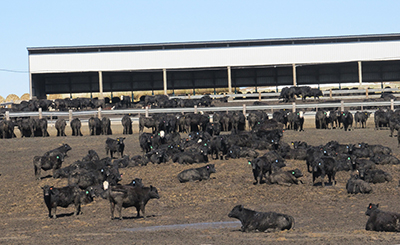Growing Beef Newsletter
April 2025, Volume 15, Issue 10
Muddy Feedlots – Now What?
Beth Doran, ISU Extension and Outreach beef specialist
 As I write, Iowa is beset with reduced visibility, freezing rain, and blowing snow. With spring warming, these blizzard conditions will eventually lead to wet and muddy feedlots – a big problem.
As I write, Iowa is beset with reduced visibility, freezing rain, and blowing snow. With spring warming, these blizzard conditions will eventually lead to wet and muddy feedlots – a big problem.
Cattle comfort and performance can be enhanced with a clean, dry feedlot surface – easier said than done given recent weather, but critical. Mud reduces feed intake, increases energy needed to walk, and elevates the net energy requirement for maintenance – all leading to a reduction in feed efficiency, average daily gain, and profitability.
Mud and manure reduce the insulation of the hair coat which increases winter cold stress and summer heat stress for the animal. A dirty hide not only reduces the dressing percent of the animal and value of the hide but may increase the potential for E. Coli 0157:H7. It also can impair animal health, predisposing the animal to increased lameness and respiratory issues.
Hence, keeping cattle clean and dry is beneficial to the beef industry. There is a scoring system to evaluate the amount of mud and manure on an animal available. Scores range from 1 (no mud/manure on hide) to 5 (lumps of mud/manure continuously on the underbelly and side of animal from front to rear.) A good goal is to strive for scores of 2 or 3.
Cattle producers can take steps to manage mud and manure. These are detailed in this Iowa Beef Center video.
- Divert clean water – construct terraces around the feedlot perimeter to prevent excess water from entering the feedlot.
- Construct well-designed mounds – the ideal mound is built parallel to the lot drainage with one side joining the feedbunk apron and waterer. Most are built of soil, preferably clay. Allow 50-60 square feet of mound space per head for today’s larger cattle. See this Beef Cattle Handbook fact sheet on mound construction.
- An emergency mound – may be constructed by placing whole round bales in areas with less mud. Add 4 lb. of bedding per head daily to achieve a working bed pack.
- Provide adequate lot drainage – allow time for solids to settle in the feedlot solids setting system. Begin releasing effluent by removing the top horizontal board (or dislodging sediment from one of vertical slats.) DO NOT allow effluent to reach a “water of the state” such as a ditch or creek.
- Maintain clean and bedded pens – bunk aprons should be cleaned a minimum of once or twice weekly. Add bedding to the existing mound at the same time.
- Provide adequate bedding – provide one pound of bedding per animal daily for every inch of mud.
- Have rain and snow plans – if precipitation is expected, remove manure prior to the approaching storm. Removal of snow from the pen after the weather event speeds drying of the feedlot surface and lessens the volume of effluent in the solids settling system.
- Consider increasing animal space – this significantly reduces the depth of mud in the pen and improves cattle mud scores. If worst case and there are no extra pens, allow cattle to access an adjacent field.
There is no easy solution to managing mud and manure in the feedlot. Success depends on well-designed pens and proactive management!
This monthly newsletter is free and provides timely information on topics that matter most to Iowa beef producers. You’re welcome to use information and articles from the newsletter - simply credit Iowa Beef Center.
